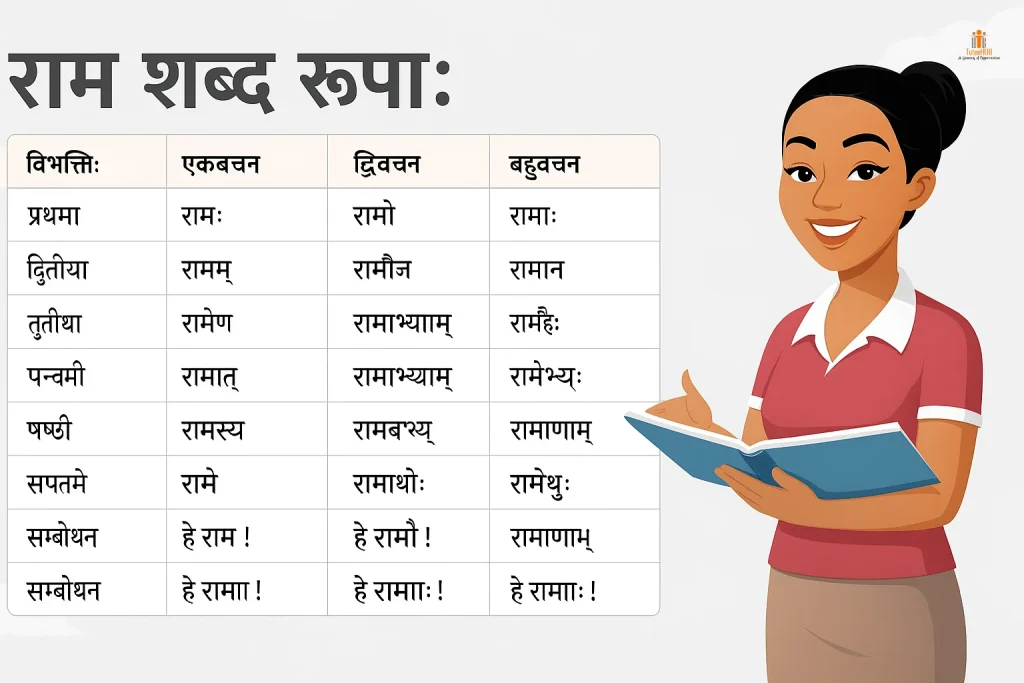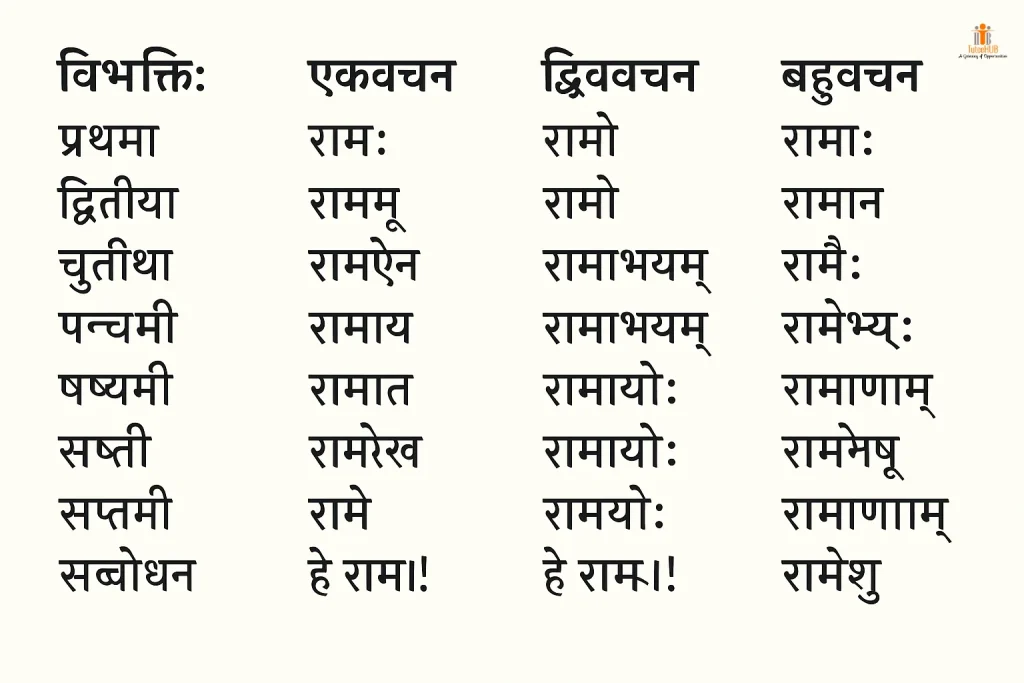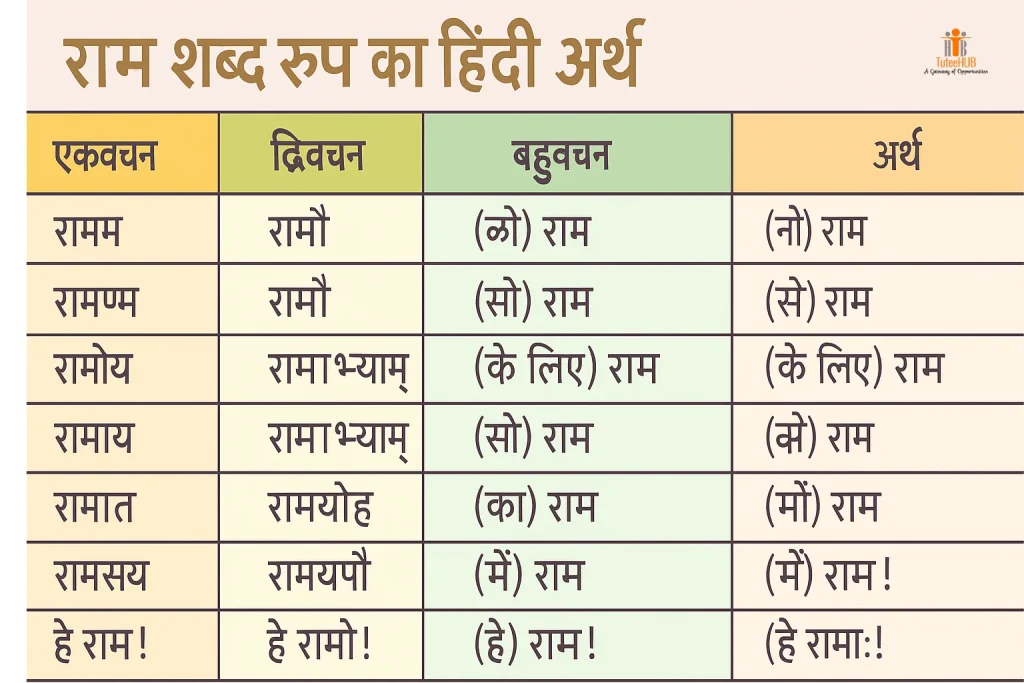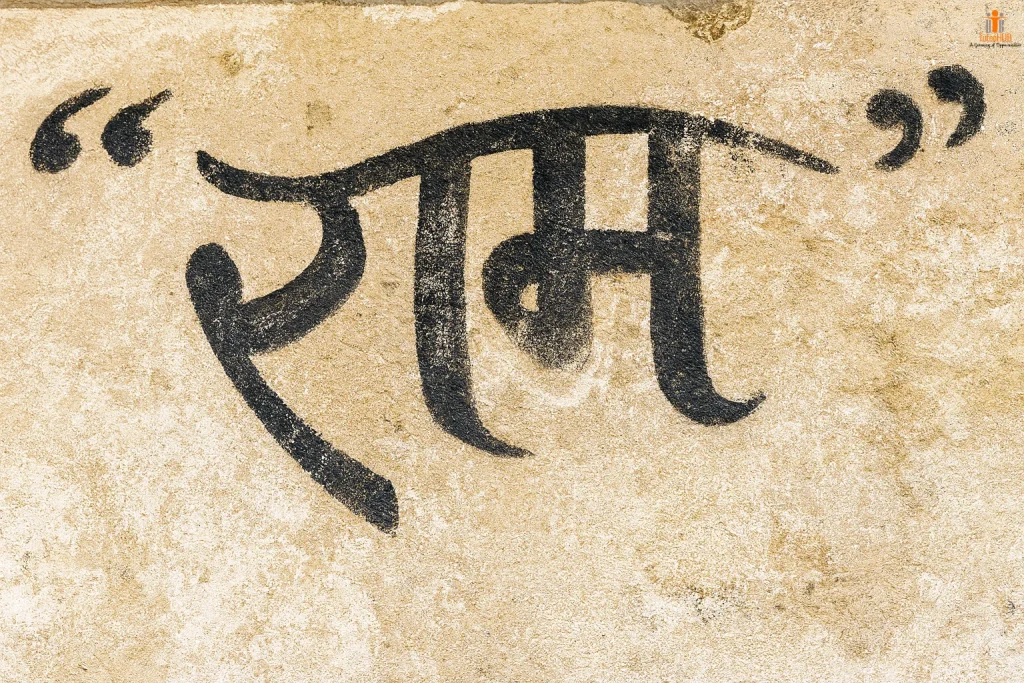Learning Sanskrit can be a rewarding experience, and understanding ram shabd roop is a crucial part of it. In Sanskrit grammar, "ram shabd roop" refers to the various forms a word takes based on its grammatical context. Mastering these forms is essential for effective communication in Sanskrit.
The concept of "ram shabd roop" might seem daunting at first, but with the right approach, it can be made simple. This article aims to simplify the learning process by presenting the information in an easy-to-understand format, complete with tables to help you grasp the different forms of "ram shabd roop" quickly.
By the end of this article, you will have a clear understanding of how to use "ram shabd roop" correctly in Sanskrit sentences, enhancing your ability to read, write, and speak Sanskrit with confidence.
Key Takeaways
- Understanding the concept of "ram shabd roop" in Sanskrit grammar.
- Learning the different forms of "ram shabd roop" with the help of tables.
- Practical tips for mastering Sanskrit grammar.
- Enhancing your Sanskrit reading, writing, and speaking skills.
- Applying "ram shabd roop" in everyday Sanskrit sentences.

The Foundation of Sanskrit Noun Declension
Understanding the basics of Sanskrit noun declension is crucial for learners, and it all begins with the concept of "shabd roop." In Sanskrit grammar, "shabd roop" refers to the various forms a noun takes based on its grammatical case and number.
What is शब्द रूप (Shabd Roop) in Sanskrit?
"Shabd roop" is a fundamental concept in Sanskrit grammar that explains how nouns change their form according to their grammatical function in a sentence. It is essential to understand that "shabd roop" is not just about memorizing different forms but also about grasping the underlying grammatical rules that govern these changes.
https://youtu.be/Z636dI-2VUg
The Eight Cases and Three Numbers System
Sanskrit nouns are declined based on an intricate system involving eight cases and three numbers. The eight cases are: Prathama (Nominative), Dvitiya (Accusative), Tritiya (Instrumental), Chaturthi (Dative), Panchami (Ablative), Shashthi (Genitive), Saptami (Locative), and Sambodhan (Vocative). The three numbers are: Singular, Dual, and Plural. This system allows for precise expression of a noun's role in a sentence.
The combination of these cases and numbers results in multiple forms for each noun, making "shabd roop" a comprehensive and complex aspect of Sanskrit grammar. For instance, the noun "Ram" will have different forms based on its case and number, illustrating the concept of "shabd roop" in action.To illustrate this, consider the following list of cases and their primary functions:
- Prathama (Nominative): Subject of the sentence
- Dvitiya (Accusative): Direct object
- Tritiya (Instrumental): Means by which something is done
- Chaturthi (Dative): Indirect object or recipient
- Panchami (Ablative): Source or origin
- Shashthi (Genitive): Possessor or attribute
- Saptami (Locative): Location or time
- Sambodhan (Vocative): Address or invocation
Why राम शब्द रूप Is Essential for Sanskrit Learners
For those embarking on the journey of learning Sanskrit, grasping राम शब्द रूप is essential due to its cultural and grammatical significance. This fundamental concept not only introduces learners to the intricacies of Sanskrit noun declension but also provides insights into the rich cultural heritage associated with the name "Ram."
The Archetypal A-ending Masculine Noun
राम शब्द रूप serves as an exemplary model for A-ending masculine nouns in Sanskrit. Its declension across various cases and numbers offers a comprehensive understanding of the grammatical rules governing this class of nouns. By mastering राम शब्द रूप, learners can easily extend their knowledge to other similar nouns, thereby enhancing their grasp of Sanskrit grammar.Cultural Significance of राम in Sanskrit Tradition
The name "Ram" carries profound cultural and religious significance in the Sanskrit tradition. As a central figure in the epic Ramayana, Ram embodies virtues such as duty, loyalty, and righteousness. Understanding राम शब्द रूप thus not only aids in linguistic proficiency but also deepens one's appreciation of the cultural narratives embedded in Sanskrit literature.
By recognizing the importance of राम शब्द रूप, Sanskrit learners can appreciate the language's role in preserving ancient Indian culture and values. This understanding fosters a more nuanced connection to the texts and traditions that have shaped the cultural landscape of India and beyond.
Complete राम शब्द रूप (Ram Shabd Roop) Table Overview
The comprehensive 'राम शब्द रूप' table offers insights into Sanskrit noun declension. This table is essential for understanding how the word 'राम' (Ram) changes across different cases and numbers.
Comprehensive Declension Chart
The declension chart for 'राम' illustrates its various forms across the eight cases (विभक्ति) and three numbers (वचन). Here is a simplified representation:
Case (विभक्ति) | Singular (एकवचन) | Dual (द्विवचन) | Plural (बहुवचन) |
प्रथमा (Nominative) | रामः | रामौ | रामाः |
द्वितीया (Accusative) | रामम् | रामौ | रामान् |
Pronunciation Guide for Each Form
Pronouncing 'राम' correctly in its various forms is crucial. For instance, 'रामः' (Ramah) in the nominative singular is pronounced with a soft 'ह' sound, while 'रामम्' (Ramam) in the accusative singular has a nasalized 'म्' sound.The stress patterns in Sanskrit declension, including 'राम शब्द रूप,' follow specific rules. Generally, the penultimate syllable is stressed in a word. For example, in 'रामेण' (Ramena), the stress is on 'मे'.
Understanding these patterns can significantly improve one's pronunciation and comprehension of Sanskrit texts.
प्रथमा विभक्ति (Nominative Case) of राम
Understanding the nominative case of "राम" is crucial for Sanskrit learners. The nominative case is essential as it identifies the subject of a sentence.
Singular: रामः, Dual: रामौ, Plural: रामाः
The declension of "राम" in the nominative case varies across singular, dual, and plural forms. In the singular, "रामः" is used, while in the dual, it's "रामौ," and in the plural, it becomes "रामाः."Subject Function in Sanskrit Sentences
The nominative case of "राम" is used when "राम" is the subject of the sentence. For example, "रामः सीताम् अन्वयत्" means "Rama searched for Sita."
Example Verses from Classical Texts
Classical Sanskrit texts often use "रामः" as the subject. For instance, in the Ramayana, "रामः वनम् अगच्छत्" translates to "Rama went to the forest."
These examples illustrate how "राम" in the nominative case functions as the subject, driving the action in the sentence.
द्वितीया विभक्ति (Accusative Case) of राम
In Sanskrit, the द्वितीया विभक्ति of राम is used to indicate the direct object, which is essential for clear communication. The accusative case forms of राम are used when it functions as the object in a sentence.
Forms of राम in Accusative Case
The forms of राम in the accusative case vary across singular, dual, and plural numbers. Understanding these forms is crucial for accurate sentence construction.
- Singular: रामम्
- Dual: रामौ
- Plural: रामान्
Object Function in Sanskrit Grammar
In Sanskrit grammar, the accusative case is used to indicate the direct object of a verb. For example, in the sentence "I see Ram," "Ram" would be in the accusative case.
Common Verbs Used with Accusative राम
Several verbs commonly take राम in the accusative case. Some of these verbs include:
Verb | Meaning |
पश्यति | sees |
वन्दते | praises |
नमति | bows to |
Mastering the accusative case of राम is a significant step in understanding Sanskrit grammar and constructing meaningful sentences.
तृतीया विभक्ति (Instrumental Case) of राम
Understanding the instrumental case of राम is crucial for mastering Sanskrit grammar. The instrumental case is used to express actions performed with or by राम, and it plays a significant role in constructing complex sentences in Sanskrit.Forms of राम in the Instrumental Case
The declension of राम in the instrumental case varies across different numbers. The forms are as follows:
- Singular: रामेण
- Dual: रामाभ्याम्
- Plural: रामैः
Expressing "With Ram" or "By Ram"
The instrumental case is used to indicate the means by which an action is performed. For example, "रामेण कृतम्" means "done by Ram." This case is essential for expressing complex relationships between entities in a sentence.
Instrumental Case in Sanskrit Poetry
In Sanskrit poetry, the instrumental case is often used to create nuanced and layered meanings. Poets use this case to convey the instrument or means by which an action is performed, adding depth to their verses. For instance, the instrumental case can be used to describe the tools or companions used in a particular action, enriching the poetic narrative.
The use of the instrumental case in Sanskrit poetry highlights the language's ability to convey complex ideas with precision and elegance.
चतुर्थी विभक्ति (Dative Case) of राम
In Sanskrit, the dative case is used to signify the indirect object or the purpose behind an action, as seen in the declension of राम. The dative case, or चतुर्थी विभक्ति, plays a crucial role in understanding the syntax and meaning of Sanskrit sentences.
Forms of राम in the Dative Case
The forms of राम in the dative case vary across singular, dual, and plural numbers. Specifically, they are:
- Singular: रामाय
- Dual: रामाभ्याम्
- Plural: रामेभ्यः
Indicating Purpose or Recipient
The dative case is primarily used to indicate the recipient of an action or the purpose for which something is done. For example, "रामाय दानम्" means "a gift to Ram."
Dative Usage in Religious Contexts
In religious contexts, the dative case is often used to express offerings or prayers to deities. For instance, "रामाय नमः" translates to "salutations to Ram," highlighting the use of the dative case in conveying reverence.Understanding the dative case of राम enhances one's grasp of Sanskrit grammar and its application in various contexts, including religious and literary works.
पंचमी विभक्ति (Ablative Case) of राम
In Sanskrit, the ablative case is used to express various relationships, including "from" and "than." The ablative case, known as पंचमी विभक्ति in Sanskrit, is crucial for understanding the declension of nouns like राम.
Forms of राम in the Ablative Case
The forms of राम in the ablative case are as follows:
- Singular: रामात्
- Dual: रामाभ्याम्
- Plural: रामेभ्यः
These forms are used to indicate the source or origin of something, often translated as "from Ram."
Expressing "From Ram" or "Than Ram"
The ablative case is used to express the sense of "from" or "than" in comparisons. For example, "रामात् बलवत्तरः" means "stronger than Ram."
Comparative Constructions Using Ablative
In comparative constructions, the ablative case is used to denote the object being compared. For instance:
- रामात् शूरः - Braver than Ram
- सीता रामात् सुन्दरी - Sita is more beautiful than Ram
This usage is significant in forming comparative sentences in Sanskrit, highlighting the importance of mastering the ablative case. Understanding the ablative case of राम enhances one's ability to form complex sentences and comparisons in Sanskrit, a crucial aspect of mastering the language.
षष्ठी विभक्ति (Genitive Case) of राम
Understanding the genitive case of 'राम' is essential for learners of Sanskrit to grasp how possession and relationships are conveyed. The genitive case, or षष्ठी विभक्ति, plays a crucial role in Sanskrit grammar.
Forms of राम in the Genitive Case
The genitive case forms of 'राम' vary across singular, dual, and plural numbers. These forms are crucial for expressing different types of possession or relationship.
Number | Form |
Singular | रामस्य |
Dual | रामयोः |
Plural | रामाणाम् |
Showing Possession or Relationship
The genitive case is used to indicate possession or a relationship between entities. For example, 'रामस्य पुस्तकम्' means 'Ram's book'. This construction is fundamental in Sanskrit for conveying ownership or association.
Genitive Compounds in Sanskrit
Genitive compounds are a significant aspect of Sanskrit grammar, where the genitive case is used to form compounds that express complex relationships. Understanding these compounds is vital for advanced learners.The genitive case of 'राम' and its application in compounds enriches the understanding of Sanskrit grammar and its nuances.

सप्तमी विभक्ति (Locative Case) of राम
Understanding the locative case of राम is essential for mastering Sanskrit grammar. The locative case is used to indicate location or time, providing crucial context to sentences.
Forms of राम in Locative Case
The locative case of राम has distinct forms for singular, dual, and plural numbers. These forms are:
- Singular: रामे (Rame)
- Dual: रामयोः (Ramayoh)
- Plural: रामेषु (RameshU)
Number | Form | Example |
Singular | रामे | Rame (in Rama) |
Dual | रामयोः | Ramayoh (in two Ramas) |
Plural | रामेषु | RameshU (among Ramas) |
Indicating Location or Time
The locative case is vital for expressing where or when an action takes place. For instance, "रामे" can be used to say "in Rama" or "at Rama's place."
Locative Absolute Constructions
Locative absolute constructions are a significant aspect of Sanskrit grammar, where a noun or pronoun in the locative case is used along with a participle to provide additional information about the circumstances of the main action. For example, "रामे स्थिते" means "Rama being present" or "with Rama being there."संबोधन प्रथमा (Vocative Case) of राम
The vocative case of "राम" is a crucial aspect of Sanskrit grammar that enables effective direct address. It is used to invoke or call someone directly, playing a significant role in dialogues and devotional contexts.
Forms of राम in Vocative Case
The forms of "राम" in the vocative case vary across numbers. Understanding these forms is essential for correct usage.
Number | Vocative Form |
Singular | राम |
Dual | रामौ |
Plural | रामाः |
Direct Address in Sanskrit Dialogues
The vocative case is particularly important in dialogues, where it is used to address characters directly. This grammatical case adds depth and clarity to the narrative.
Vocative Forms in Devotional Literature
In devotional literature, the vocative form of "राम" is frequently used in prayers and hymns, serving as a means to invoke the divine. This usage underscores the reverence and intimacy inherent in devotional practices.Mnemonic Techniques for Mastering राम शब्द रूप
Mnemonic techniques offer a powerful tool for memorizing 'ram shabd roop' and enhancing Sanskrit language skills. These techniques can help learners recall the various forms of राम शब्द रूप more effectively.
Visual Memory Aids for Case Endings
Visual memory aids can be particularly helpful in remembering the different case endings of राम शब्द रूप. For instance, creating mental images that associate with each case can make recall easier. Using visual cues like diagrams or charts can also enhance memory retention.Rhythmic Patterns for Memorization
Rhythmic patterns or rhymes can be used to memorize the various forms of राम शब्द रूप. By creating a rhythmic sequence that corresponds to the different case endings, learners can more easily commit these forms to memory. This method leverages the brain's ability to remember rhythmic information better than plain text.
Association Techniques for Different Cases
Association techniques involve linking the different cases of राम शब्द रूप to memorable events, words, or images. For example, associating the prathama vibhakti (nominative case) with a specific story or image can aid in recall. This method helps in creating a mental connection that makes the information more memorable.
By combining these mnemonic techniques, learners can develop a robust system for mastering राम शब्द रूप, making their Sanskrit learning journey more efficient and enjoyable.

Grammatical Rules Governing अकारान्त पुंल्लिङ्ग Declension
Understanding the declension of अकारान्त पुंल्लिङ्ग nouns like राम is crucial for mastering Sanskrit grammar. These nouns follow specific patterns that are influenced by grammatical rules, including sandhi rules and exceptions.Sandhi Rules Affecting राम Forms
Sandhi rules play a significant role in the declension of राम. Sandhi, which refers to the combination or junction of sounds, affects how the noun is declined across different cases. For instance, when राम is followed by a word beginning with a vowel, sandhi rules dictate the resulting sound combination.
"The application of sandhi rules in Sanskrit declension is akin to the harmony of sounds in music," as noted by Sanskrit grammarians. This highlights the importance of understanding these rules for accurate pronunciation and comprehension.
Exceptions and Special Cases
While राम follows a standard pattern for अकारान्त पुंल्लिङ्ग nouns, there are exceptions and special cases to be aware of. Certain nouns may deviate from the typical declension pattern due to historical or contextual reasons.
Historical Evolution of These Forms
The declension patterns of अकारान्त पुंल्लिङ्ग nouns like राम have evolved over time, influenced by the historical development of Sanskrit. Understanding this evolution can provide insights into the linguistic and cultural context of ancient Sanskrit texts.
For example, some nouns exhibit irregularities in their declension due to archaic forms that have been preserved in specific contexts. Recognizing these irregularities is essential for a nuanced understanding of Sanskrit grammar.
The study of Sanskrit declension is not just about memorizing forms; it's about understanding the underlying grammatical rules that govern the language. By mastering these rules, learners can better appreciate the complexity and beauty of Sanskrit.
Comparing राम with Similar Sanskrit Declensions
The declension pattern of राम serves as a model for other A-ending masculine nouns in Sanskrit. Understanding these similarities and differences is crucial for mastering Sanskrit grammar.
Other A-ending Masculine Nouns
Nouns like कृष्ण, शिव, and देव follow the same declension pattern as राम. For instance, the nominative singular form of कृष्ण is कृष्णः, just like रामः. Here are some examples:
- कृष्णः (Nominative Singular)
- शिवः (Nominative Singular)
- देवः (Nominative Singular)
These nouns are declined similarly across all cases and numbers, making it easier for learners to grasp the pattern.
Differences from I-ending and U-ending Nouns
I-ending and U-ending masculine nouns have different declension patterns. For example, I-ending nouns like कवि (poet) and U-ending nouns like शिशु (child) follow distinct patterns. The differences are evident in their case endings.
Noun Type | Nominative Singular | Accusative Singular |
A-ending (राम) | रामः | रामम् |
I-ending (कवि) | कवि: | कविम् |
U-ending (शिशु) | शिशु: | शिशुम् |
Feminine Counterparts
The feminine counterparts of these masculine nouns, such as रमा and सीता, follow different declension patterns. For example, रमा (a feminine noun) is declined differently from राम.Understanding these differences is essential for accurate usage in sentences. By comparing राम with other nouns, learners can develop a deeper understanding of Sanskrit grammar and improve their proficiency.
Practical Exercises to Master राम Declension
Mastering राम declension requires consistent practice and the right exercises. To become proficient, learners should engage in a variety of activities that reinforce their understanding of this fundamental Sanskrit concept.

Progressive Practice Drills
Begin with simple exercises like reciting the राम शब्द रूप table from memory. Gradually move on to more complex drills, such as filling in the blanks with the correct case endings or identifying the correct form of राम in different sentences.Translation Challenges
Translation exercises are an effective way to practice राम declension in context. Try translating sentences that use different cases of राम, such as "रामः वनं गच्छति" (Rama goes to the forest). This helps reinforce understanding of how the various forms are used in practical contexts.
Composition Activities Using All Cases
For advanced practice, compose short paragraphs or stories using all eight cases of राम. This challenging exercise helps solidify the learner's grasp of the different forms and their appropriate uses. For example, a short paragraph might describe राम's journey, using the locative case to indicate where he traveled and the instrumental case to describe how he accomplished his tasks.
By incorporating these practice exercises into their study routine, learners can achieve a deeper understanding of राम declension and improve their overall proficiency in Sanskrit.
Digital and Traditional Resources for Learning राम शब्द रूप
In today's digital age, numerous resources are available for mastering राम शब्द रूप. Learners can now access a variety of tools and materials that cater to different learning styles and preferences.
Sanskrit Learning Apps and Websites
Several apps and websites have been developed to aid in the study of Sanskrit. Apps like "Sanskrit Learning" and "Samskrta Bharati" offer interactive lessons and exercises to help learners understand राम शब्द रूप. Websites such as Sanskrit.org and LearnSanskrit.org provide comprehensive guides, including declension tables and practice exercises.
These digital resources are particularly useful due to their accessibility and the ability to update content regularly. As noted by a prominent Sanskrit scholar,
"The digital revolution has made it possible for learners to access Sanskrit resources from anywhere in the world, at any time."
Traditional Textbooks and References
Despite the rise of digital resources, traditional textbooks remain a valuable tool for learning राम शब्द रूप. Textbooks such as "Sanskrit Grammar" by William Dwight Whitney and "A Sanskrit Grammar for Students" by Arthur Anthony Macdonell are highly regarded for their detailed explanations and examples.
These texts often include detailed declension tables and examples that illustrate the usage of राम शब्द रूप in different contexts. They are particularly useful for those who prefer a more traditional approach to learning.
Online Communities for Sanskrit Learners
Joining online communities can be a great way to stay motivated and get support while learning राम शब्द रूप. Forums like Reddit's r/Sanskrit and Sanskrit subreddit allow learners to ask questions, share resources, and engage in discussions about Sanskrit grammar and literature.
These communities are not only a resource for learning but also a way to connect with others who share an interest in Sanskrit. As the popularity of Sanskrit learning grows, so does the number of resources available to learners.
Conclusion: The Path to Sanskrit Mastery Through राम शब्द रूप
Mastering राम शब्द रूप is a crucial step towards achieving Sanskrit mastery. Through this comprehensive guide, learners can now understand the declension of राम across various cases and numbers, enhancing their grasp of Sanskrit grammar.
The detailed exploration of राम शब्द रूप has not only shed light on the intricacies of Sanskrit noun declension but also provided a foundation for further learning. By applying the mnemonic techniques and practicing with the exercises provided, learners can reinforce their understanding and build confidence in their Sanskrit skills.
As learners progress on their journey to Sanskrit mastery, the knowledge of राम शब्द रूप will serve as a valuable reference point. It is through the dedicated study of such fundamental concepts that one can truly appreciate the beauty and complexity of the Sanskrit language.
Embracing राम शब्द रूप is embracing a part of Sanskrit's rich heritage, bringing learners closer to the language's profound cultural and spiritual significance. Continue to explore and practice, and the path to Sanskrit mastery will become increasingly clear.








Comments(1)